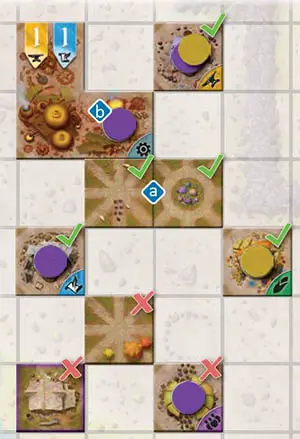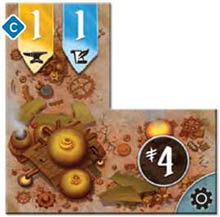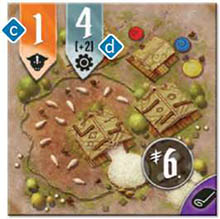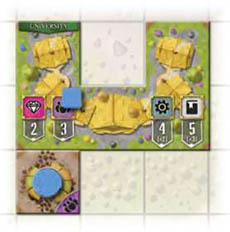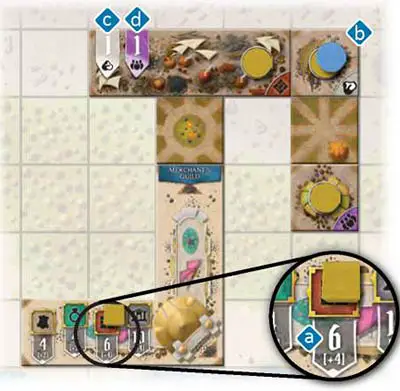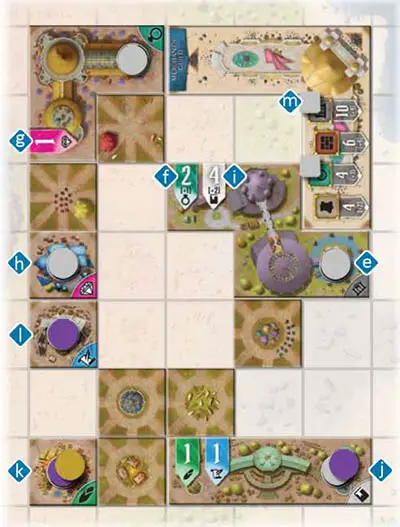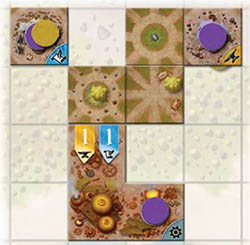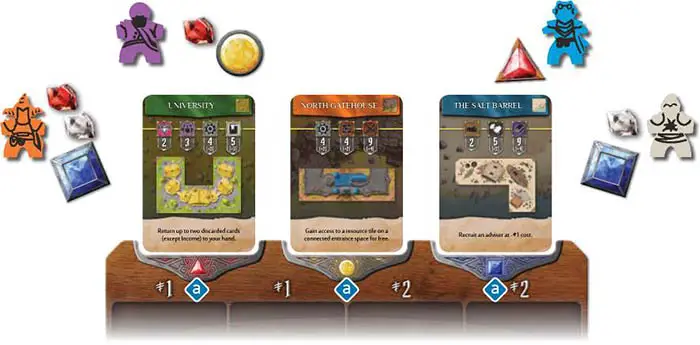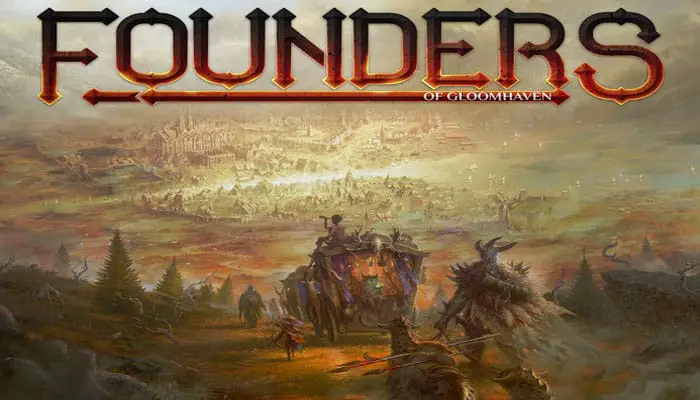
In the age after the Demon War, the continent enjoys a period of prosperity. Humans have made peace with the Valrath and Inox. Quatryls and Orchids arrive from across the Misty Sea looking to trade.
It is decided that a new city will be built on the eastern shores - a hub of trade and a symbol of many races working in harmony. Each race brings their own specialty to the city, and each race holds a desire for influence over the city by contributing the most to its construction.
In Founders of Gloomhaven, 1-4 players will lead a race of Gloomhaven residents, working to build prestigious structures in the city by delivering various resources to them.
The game is competitive, but players must work together, combining their basic resources into more advanced and lucrative ones, all the while managing the delicate configuration of building tiles on the map.
Components

- Double-sided map board
- 9 Player mats
- 24 Basic resource trade stalls
- 21 Prestige building tiles
- 22 Standard action cards
- 6 Completion markers
- Adviser/Proposal board
- 27 Worker pawns
- 18 Tier 2 resource buildings
- 21 Prestige building cards
- 18 Adviser cards
- 68 Money tokens
- Resource tracker board
- 12 Vote tiles
- 12 Tier 3 resource buildings
- 8 Basic resource cards
- 15 Achievement cards
- 9 Gloomhaven city events
- 64 Road tiles
- 27 House tiles
- 27 Bridge/Gate tiles
- 40 Influence tokens
- 135 Claim tokens
- 225 Delivery tokens
- Active player token
- Rulebook
Setup
Each player starts with:
Three voting tiles (a circle, a square, and a triangle)

7 in money tokens

 Five (six in a 2-player game) standard action cards of their color ("Recruit", "Trade", "Upgrade", "Construct", and "Call to Vote" [and "Income" in a 2-player game])
Five (six in a 2-player game) standard action cards of their color ("Recruit", "Trade", "Upgrade", "Construct", and "Call to Vote" [and "Income" in a 2-player game])
Choose a side of the map board to play on (either thematic or symmetric) and place it between the players.
Make sure all basic, tier 2, and tier 3 resource tiles are within easy reach of everyone, along with the money tokens, influence tokens, and road tiles.

Place the adviser and proposal board below the map, then shuffle the prestige building cards and place them next to this board face down.
Do the same with the adviser cards, shuffling the tier 1, tier 2, and tier 3 cards separately, and then ordering them with the 3s on the bottom and the 1s on top a. Also place the resource tracker board in view of everyone.
A note on the two maps:
The thematic map
b, with the compass rose in the bottom right corner, is meant to emulate the ruins upon which Gloomhaven was built.There are fewer total spaces, and the river and walls have more restrictive placements, creating a much tighter board that could lead to more instances of aggressive blocking moves by the players.
The symmetric map
c, on the other hand, has no thematic grounding, but is designed to present a more open board that should lead to a more friendly game.
Deal out three prestige building cards d from the bottom of the deck to the three spaces at the top of the adviser and proposal board e and deal out four adviser cards f to the four spaces at the bottom of this board (the adviser offer).
If two of the same type (both shape and color) of prestige buildings are dealt out, place the rightmost one on the top of the draw deck and replace it.

Randomly determine a starting player and give that player the active player token. Player order will be determined from the starting player and go clockwise around the table. In player order, players will choose a race, collecting all of the following:
- Their race's player mat with the "a" side face up.
g - Three trade stall tiles
hof the basic resource depicted on the race's mati - Three bridge/gate tiles of the race's color, placed on the right side of the race's mat.
j - Three house tiles of the race's color, placed on the left side of the race's mat.
k - Three worker pawns of the race's color. These pawns are placed on the player's house tiles
land are unavailable at the beginning of the game. - 25 claim tokens
mand 15 delivery tokensnof the race's color. One claim token is placed on the "0" space of the score track along the edge of the board. - The resource card
ocorresponding to the race's resourcep, which is flipped over and used as a resource reference.
Once all players have chosen a race, take the remainder of the resource cards and, in reverse player order, starting with the last player, players must now choose an additional resource to control by taking a corresponding resource card q from those remaining and the set of three corresponding resource trade stall tiles r.
This resource card is placed on the designated space of the player mat. A player may not, however, claim a resource card that is forbidden by their race (denoted by the red resource symbols in the center of their player mat) (s).

2-player Rule:
After each player has claimed their first resource card (second total resource, including their race's resource), in player order, the players will now choose a third resource to control t.
Note that resource cards also have forbidden resource symbols u, such that this third choice must not be forbidden by their race or secondary resources..

Aesthers:
Unlike other races, Aesthers have no set racial resource. If they are chosen, the player may take any resource card from those remaining and place it resource-side up on the designated spot on their mat.
This becomes their race's resource, and the race who normally owns this resource cannot be chosen by the other players. The Aesther player will not get a personal resource reference (back of the resource card), but they can still reference the resource tracker board.
If there are no valid resource cards left for a player when it is their turn to choose one, because of the restrictions of their race or resource card, the player instead chooses a secondary resource card already claimed by another player, forcing that player to immediately pick a new resource card from those left.
In a 2- or 3-player game, some resources will be claimed by none of the players. These are considered neutral resources. Place the trade stall tiles corresponding to these resources to the side. These can be placed on the board by any player during the game using a trade action (see p.12).
After this, in reverse player order, starting with the last player, each player places one of their race's resource trade stall tiles on any of the empty grey spaces on the board specially marked with a number equal to or lower than the player count v, then places one of their claim tokens on top of the tile.
All players should then place one of their delivery tokens on the income track of their player mats on the "1" spot w, and another one on the "own" spot of the corresponding resource on the resource tracker board x.

Character Races:

City Sections:
The city is broken into three sections. The thematic map a is separated by a river on the left and a wall on the right, and, in the case of the top center of the board, a large black square c. The symmetric map b is separated by three radial rivers and the Ghost Fortress reserved space in the middle.
The rivers/wall cannot be built upon except with bridges/gates. The black square cannot be built upon at all, nor can the spaces dedicated to the specific prestige buildings (the Gatehouses and Ghost Fortress).

Terrain Types:
Each buildable square on the board is one of four different terrain types, which have implications for what buildings can be placed on them, and the cost of importing or buying access to resources on those squares. The four types are entrance (red), coastal (white), forested (green) and central (grey).

A Note on Resources:


Game Play
Founders of Gloomhaven is a game of collaborative building. Players must work together to build the more advanced resources required to deliver to prestige buildings, all while trying to maximize their own scores.
Before delving into the structure of play, it is important to understand two core concepts: upgrading resources into higher-tier resources, and delivering resources to earn points.
Upgrading Resources
The race mats and resource cards depict various combinations of resources used to create higher-tier resources. For instance, metal and knowledge "Ef can be combined to create machinery. Metal and knowledge
 are thus prerequisite resources for machinery
are thus prerequisite resources for machinery  .
.
This means that if a player wishes to build a machinery resource building tile, they can only place the tile such that it is connected to its prerequisite resource tiles, and the player has a claim token on each of those resource tiles.
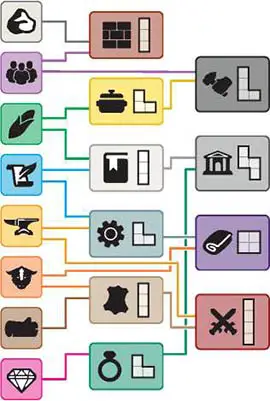
Connected means that a tile is either adjacent to the other tile in question or a line can be drawn between them through a chain of road tiles a linked by adjacency. Diagonals and orthogonals are both considered adjacent for all purposes. Connections do not chain through buildings.
Example: All tiles marked with a green check are connected to the machinery resource building tile. Those with a red X are not.
Whenever a player builds a new resource tile, they should place a claim token on that tile to denote ownership b.
Plus, if this is the first of that resource tile they own, also increase their income and place one of their delivery tokens on the "own" spot of the corresponding resource on the resource tracker board.
Delivering Resources and Earning Points
It is important to understand that all resource tiles represent an unlimited supply of that resource. The resource can be used any number of times to create higher-tier resources or deliver to prestige buildings.
Moreover, every time a resource is used, it earns points for the player who owns the tile. The amount earned is written on the building tile using the resource c.
In the case of an advanced resource building being built, its prerequisite resources are scored immediately. If there are multiple sources of a prerequisite resource connected to a resource building when it scores its prerequisites, the owner of that tile chooses which of the prerequisite resource building tiles to use and distribute points to.
Example 1: When the machinery tile is built, it uses its prerequisite resources. The owner of the metal tile it uses earns 1 point, and the owner of the knowledge tile it uses earns 1 point.
If a prerequisite resource is also an advanced resource building (in the case of a tier 3 resource being built), that prerequisite building also scores its prerequisites, but the points paid out come from the points it earned from the building being built (see example 2).
In general, any time a resource building earns points for its owner, it must pay out points to its prerequisites from the points it earned. Note, if a player owns the prerequisite themselves, they do not pay themselves any points for that resource. It is only important if another player owns a prerequisite.
Example 2: When the cloth tile is built, it also uses its prerequisite resources. The owner of the livestock tile it uses earns 1 point, and the owner of the machinery tile it uses earns 4 points.
From those 4 points, however, the owner of the machinery tile must pay out the machinery prerequisites again (see example 1), so the owner of the knowledge earns 1 point, and the owner of the metal earns 1 point, leaving 2 points remaining for the owner of the machinery tile.
If there is a point value in parentheses below the main point value, this means that the resource building has prerequisites, and the amount in parentheses is the number of points that resource earns on top of any points it pays to its prerequisites.
So when machinery earns 4 points for cloth being built, the "+2" d under this value means that after 1 point is paid to knowledge and 1 point is paid to metal, the owner of the machinery tile is left with 2 points.
Resources are also used when they are delivered to prestige buildings. As soon as any resource is connected by the owner of the resource to a prestige building that requires that resource - regardless of when it happens - that resource is delivered. It is possible for an action to result in multiple resources being delivered at once.
The player who owns the resource being delivered places a delivery token on the resource icon on the prestige building tile, and that player earns a number of points equal to the main value in the banner below the resource icon.
Once a delivery token is placed in this square, that resource cannot be delivered to that building again. If there are multiple resource tiles of the same type that could deliver to the prestige building tile when the connection is made, the player performing the connection decides which resource tile supplies the resource and earns the points.
Keep in mind that prerequisites for resources delivered are also paid out from the points earned from the delivery, as explained on the previous page. Note that in the case of a tier 3 resource being delivered, this can cause a cascade effect where the player earning points for a prerequisite tier 2 resource might have to pay some of those points to a different player supplying a basic resource to their tier 2 resource (see example 5).
Example 3: The University is placed adjacent to a population resource tile. Blue immediately delivers the population to the University, placing his delivery token on the population icon and earning 3 points.
Example 4: Yellow builds a road, connecting her brick resource building tile to the Merchant's Guild. Yellow immediately delivers the brick, earning 6 points
a.However, yellow is using blue's stone resource to make the brick
b, so she pays blue 1 point (due to the "1" in the banner with the stone icon on the brick building tile)c. She also pays 1 point to herself for using her own populationd. Yellow earns 5 points in total and blue earns 1.
Example 5: White builds a government resource building tile
eadjacent to the Merchant's Guild. Before the resource is delivered, however, points must first be distributed for the construction of the government building tile.White earns 2 points
ffor his jewelry building tile being usedg(paying 1 point to himself for the gems used by the jewelryh), and Purple earns 4 pointsifor her book building tile being usedj.Purple, however, must take those 4 points and pay 1 point to the owner of the crops
k(Yellow) and 1 point to the owner of the knowledgel(herself).Thus, White earns 2 points, Purple earns 3 points, and Yellow earns 1 point for building the government building tile.
Now the government resource is delivered to the Merchant's Guild
m, earning White 10 more points, however, he has to again pay 4 points to purple for using her book tile (White also pays 2 points to himself for the jewelry), and then Purple again pays one of those points to Yellow for using her crops to make the books.For the delivery, White earns 6 points, Purple earns 3 and Yellow earns 1. In total, White earns 8 points, Purple earns 6 points and Yellow earns 2 points.
Neutral Buildings
In a 2- or 3-player game, there will be two neutral resources. Whenever a neutral resource building would earn points, no one receives the points. All basic neutral resources are considered to have a value of 2 points instead of 1 when points are paid out for a prerequisite.
If a player builds a machinery building using a neutral metal resource, the only point awarded is to the owner of the knowledge tile.
If the player then delivers the machinery resource to a prestige building for 4 points, one of those points is given to the owner of the knowledge tile, and 2 points are lost for the metal tile, leaving the owner of the machinery tile with only 1 point (despite the "(+2)" written on the machinery delivery - essentially the value in parentheses is reduced by one for each neutral direct prerequisite).
Additionally, whenever a prestige building that requires a neutral basic resource is placed on the board, that resource is delivered immediately, regardless of connection, and a neutral delivery token is placed on the prestige tile (use tokens of a color not currently being used by a player).
Game Play Structure
Starting with the first player and going in player order, players will perform a single action by playing a card from their hand into their discard pile. Usually this will be a "Call to Work" action, however, one of each player's cards is a "Call to Vote" which retrieves all discards the player has played.
After that player's turn is fully resolved, including any follow actions (see next column), the active player token moves to the next player in player order. This is repeated until the end of the game is triggered.
Call to Work
From their hand of action cards (either a standard action card or a recruited adviser card), a player will either play one face up onto the table in front of them and take the main action of the card, or play one face down and take a basic action instead (see p.14). If a card is placed face up, the player must be able to fully resolve the card's main action.
Leading and Following
After a player plays a face up card as their call to work action and fully resolves it, all other players in player order, starting with the player to the active player's left, can then follow that call to work action.
Each player has the choice to either perform the specific follow action of the card played, or perform a basic action (see p.14). After each other player has performed a follow action, the player's turn is over, and the active player token moves.
Recruit
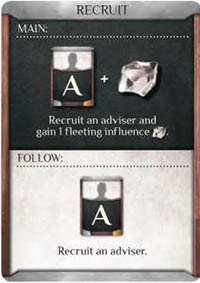
With the standard main recruit action, a player recruits one adviser card from the adviser offer and adds it to their hand, then the player gains one fleeting influence.
There are two prerequisites to recruiting an adviser card, however. The first is that the recruiting player must own or have access to the resourca depicted in the lower left of the adviser card n .
The second is that the player must pay the money com listed above the card on the adviser and proposal board (either  1 or
1 or  2).
2).

Adviser cards offer new and varied ways to perform call to work actions. The actions of each of the adviser cards is described on the cards, but all adviser cards fall into the same categories as the standard four main actions: recruit, trade, upgrade, and construct.
Whenever an adviser card is followed, the following players may perform the same follow action associated with the adviser's category, regardless of what the adviser's main action is. For example, if the Shepherd (an "Upgrade" adviser) were played, all following players would be able to perform the "Upgrade" follow action depicted on the standard "Upgrade" action card.
The recruit follow action is to also recruit an adviser from the adviser offer, but no extra fleeting influence is gained. After all players have followed this action, only then do all remaining adviser cards in the offer get shifted over to the left of the offer and then new cards from the adviser deck are dealt into the empty spaces on the right.
Some advisers have a point value  listed in the lower right of the card (either 1, or 3). When any adviser is recruited, the recruiting player earns one lasting influence plus any depicted number of points
listed in the lower right of the card (either 1, or 3). When any adviser is recruited, the recruiting player earns one lasting influence plus any depicted number of points a.

Trade
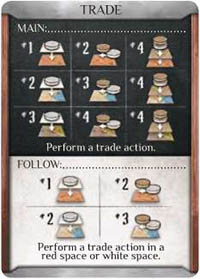
With the standard main trade action, a player can do one of three things:
-
import one of their basic resources by paying money to the bank to place the corresponding trade stall tile onto the board with their claim token on top (so long as it is not adjacent to any other tile the player owns, excluding bridges/gates) ;
-
or
bbuy access to another player's or neutral resource tile by paying money to the owning player (or to the bank in case of a neutral resource) to place a claim token under the owning player's tokenc; -
or import and immediately buy access to a neutral resource by paying money to the bank to place a neutral basic resource trade stall tile onto the board with a neutral claim token on top (use tokens of a color not currently being used by a player), and the player's claim token under it
d.
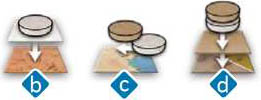
The cost paid to perform the first two of these actions is based on the color of the board space where the resource tile is located. The cost for a red space is  1 for import and
1 for import and  2 for buy access.
2 for buy access.
The cost for each of these increases by  1 if the space is white, and increases by
1 if the space is white, and increases by  2 if the space is grey or green. The cost to import and buy access to a neutral resource is *4, regardless of the color of the space on which it is placed.
2 if the space is grey or green. The cost to import and buy access to a neutral resource is *4, regardless of the color of the space on which it is placed.
The trade action can be used to buy access to other players' advanced resource buildings as well, and in such cases where the building covers multiple terrain types, use whichever color is the cheapest.
Players can also use the trade action to import and immediately buy access to another player's resource (paying the same cost as for a neutral resource: *4), but only after the second completion token has been placed on a prestige building.
Note that only one tile of each resource type can be placed in each section of the city. It is not allowed to import a resource tile to a city section that already contains that resource tile.
The trade follow action is also to import or buy access at the same prices, but this can only be done on red or white spaces. The import and immediately buy access action cannot be performed as a follow.
Any time a new claim token is placed out onto the board, be sure to track this information on the resource tracker board as well. Any time a player gains ownership of a new resource, a delivery token should be placed on the "own" space of the corresponding resource on the tracker e (and their income tracker should be increased by one).
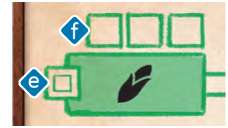
Any time a player gains access to a new resource, a delivery token should be placed on the "access" space of the corresponding resource on the tracker f.
Upgrade
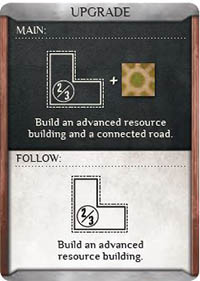
With the basic main upgrade action, a player can pay to build one advanced resource building tile, either  4 for a tier 2 resource building or
4 for a tier 2 resource building or  6 for a tier 3 resource building. In addition, either before or after placing the tile, the player may also build a single road connected to the resource tile being built. In general, if an action specifies that a player can build "connected" roads, this is what that means.
6 for a tier 3 resource building. In addition, either before or after placing the tile, the player may also build a single road connected to the resource tile being built. In general, if an action specifies that a player can build "connected" roads, this is what that means.
When a player places the resource building, they also place a claim token on that tile to denote ownership. Plus, if that is the first of that resource tile that they own, also increase their income and place one of their delivery tokens on the "own" spot of the corresponding resource on the resource tracker board.
When placing the tile, it must be connected to prerequisite resource building tiles that player owns or has access to, connected to something the player owns, and cannot be adjacent to any other tile the player owns, excluding bridges/gates.
Tier 2 and 3 resource building tiles can be placed on any terrain color, but each city section can only have one resource tile of each type. Resources used to build the higher-tier resource building, including the player's own buildings, earn points for the player who owns them, depicted by values on the tile being built.
The upgrade follow action is to also build an advanced resource building at the same prices following normal placement rules, but the extra road is not built.
Example: Purple takes an upgrade action to build the machinery resource building tile. She pays *4 and places the tile on the board such that it is connected to metal and knowledge that she owns or has access to. Purple earns 1 point for the metal tile being used and yellow earns 1 point for the knowledge tile being used.
Construct
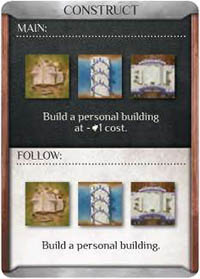
With the standard main construct action, a player can build one of their personal buildings, either a house or a bridge/gate. Personal buildings, like advanced resources and roads, can only be put in a space connected to something the player already owns.
Normally, the cost to build a personal building is  4, but this main action reduces the cost by
4, but this main action reduces the cost by  1.
1.
Houses
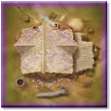
Each house tile built immediately unlocks an additional worker pawn for the player. These are sometimes used when performing a basic action. In addition, when collecting income, each house built by a player gives him or her 1 fleeting influence g.
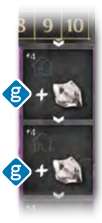
Each player can build up to three houses. Houses can only be built on green spaces and each one must be built in a different section. Houses also cannot be adjacent to any other tile the player owns, except bridges/gates.
Bridges/gates
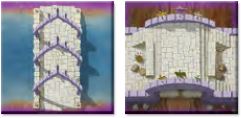
Bridges/gates are the only way to connect buildings across rivers/walls that separate city sections. A built on a river/wall space.
Once built, this space acts as a road tile, but only for the player who built it. This means that this player can consider buildings in different sections connected, but other players must build their own bridges/walls to gain the same benefit. Each player can build up to three bridges/gates.
The construct follow action is to also build a personal building, but with no discount.
Basic Actions
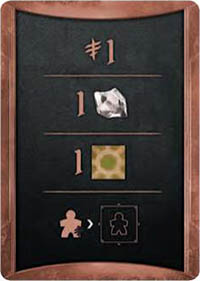
Whenever a player follows the action of another player, the following player can either perform the follow action associated with the triggering action, or they can perform a basic action. In addition, on a player's turn, they can play a card face down to perform a basic action, and this does not trigger a follow action for the other players.
A basic action is one of the following:
- Gain
 1
1 - Gain 1 fleeting influence
- Build one road connected to something the player owns
- Place a worker to perform a racial action or a prestige building action
Performing A Racial Action
As a basic action, a player places one of their workers onto the worker space on their race mat and performs the action described a. This cannot be done if the player has no available workers or if there is already a worker in the worker space.

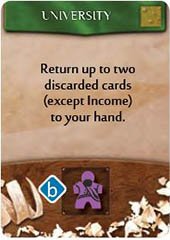
Performing A Prestige Building Action
As a basic action, a player places one of their workers onto the worker space on an active prestige building card and performs the action described on the card b.
A player can only perform the actions of prestige buildings that they have a delivery token on, and this cannot be done if the player has no available workers or if there is already a worker on the prestige building card.
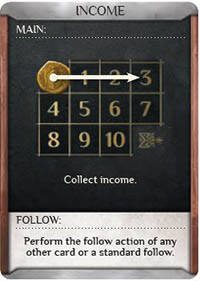
2-player Action: Income
In a 2-player game, each player should also have a standard main income action card. When this card is played, the player collects income (see right).
When following the income action, the other player can treat the income card as any type of main action, meaning they can perform the recruit, trade, upgrade, or construct follow action, or perform a basic action.
Call To Vote
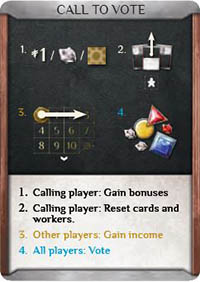
When a player has at least two cards played in front of him or her from previous turns (three cards in a 2-player game), that player then has the option to play their "Call to Vote" card face up, which triggers a number of things.
The "Call to Vote" card cannot be played face down for a basic action.
Resetting
First, the player calling the vote either gains *1, gains 1 fleeting influence, or builds one road connected to something they own for each card left in their hand, not counting the "Call to Vote" card.
For instance, if a player has two cards left in their hand, they could gain *1 and build one road.
Once these benefits are resolved, the player then returns all played cards to their hand, including the "Call to Vote" card, and collects all their workers currently occupying the race mat or prestige building cards so these workers can be used again.
Income
Next, every other player (not the player who called the vote) then collects income. Players first collect money equal to the income value on their income track.
Each time a player imports or builds a new type of resource tile they don't yet own, their income track is increased by one, such that this track is always equal to the number of unique resources the player owns on the board (or the number of delivery tokens they have on the "own" spaces of the resource tracker board).
For instance, if a player owned a crop tile, two metal tiles, two machinery tiles, and a food tile, that would result in an income of 4, and the player would collect *4. In addition, for every house a player has built, they gain 1 fleeting influence.
Building Proposal Vote
Finally, all players must then secretly decide which one out of the three building proposal cards on the adviser and proposal board they want to be built. They do this by selecting their vote tile corresponding to the shape below the desired card a, and they must also select how much influence they want to dedicate to increase the power of their vote. Each player's vote has a single influence by default.
Example: In the above situation, the circle card receives 3 influence, the square receives 6, and the triangle receives 1. The Salt Barrel is built as a result, with Orange deciding where it goes.
Each fleeting influence  dedicated counts as one extra influence, and each lasting influence
dedicated counts as one extra influence, and each lasting influence  dedicated counts as two extra influence.
dedicated counts as two extra influence.
Once all players have finalized their decisions by placing the desired vote tile and number of influence tokens in one hand and all other vote tiles and influence in their other hand, they simultaneously reveal their choices and determine which of the prestige buildings received the most influence.
In the case of a tie, the player involved in the tie with the fewest points decides between the tied buildings, and, if there is a tie for points, involved in the tie who is closest (in player order) to the player who called the vote decides.
Flip over the winning building card and place it below the adviser and proposal board, then discard the other two cards. All fleeting influence (dedicated or not) and all dedicated lasting influence is then returned to the supply.
At this point, determine which player contributed the most influence to the winning proposal. If there is a tie, the tie is resolved in the same way as when determining the winning building card above. This player takes the building tile corresponding to the winning building card and places it on the map board, following the restrictions outlined on the next page.
After the vote, three new building proposal cards should be dealt to the adviser and proposal board from the bottom of the deck to prepare for the next vote. If there are not enough cards in the draw deck to do this, the discard should be shuffled and used to make a new draw deck.
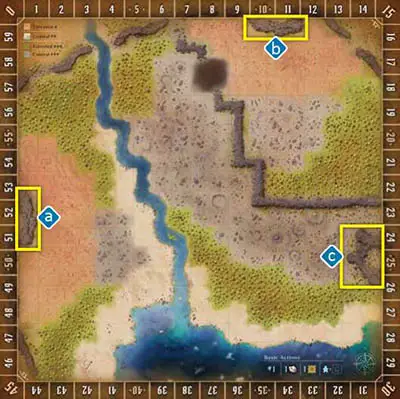 Side A |
If two cards of the same building type are drawn in the same set of three, place the rightmost one on the top of the draw deck and replace it. Each building also has a specified color, and can only be placed on the board such that at least one space of the building is on the corresponding terrain type, the building does not overlap a road tile, building tile, or unbuildable space, and there is not a prestige building tile of the same type (both shape and color) in the same city section.
The prestige building does not need to be connected to anything currently on the board. Following these rules, in very rare cases, it may be possible that a prestige building has no legal placement. In such case, the prestige building card should be removed from the game and replaced with another card.
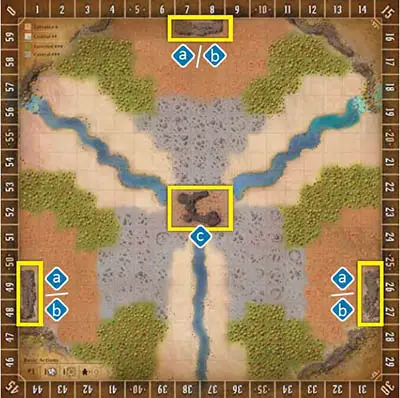 Side B |
The West Gatehouse a, North Gatehouse b and Ghost Fortress c are different in that they can only be placed on specific locations. As seen to the right, on the thematic map, the Gatehouses and Ghost Fortress have designated locations. On the symmetric map, the Ghost Fortress has a designated location in the center, and either of the Gatehouses can be placed in any of the three reserved locations.
End of the Game
Any time a prestige building has had all of its required resources delivered, place a completion token on it d. Once six completion tokens have been placed, the end of the game is triggered.

Play continues until the active player's turn has been fully resolved (including any follow actions, but before the active player token moves to the next player). Each lasting influence token is worth 1 point, and each set of  4 is worth 1 point.
4 is worth 1 point.
After these conversions are made, the player with the most points wins. If tied, the winner is the tied player closest to the current active player in player order.
Important Reminders
A player can never have two buildings they own (resource buildings or houses) adjacent to each other. Bridges/gates are an exception to this rule.
Any time something is built (including roads), the player must build it connected to something they own. Importing and buying access are not restricted by this.
Buying access to another player's resource does not confer ownership and prestige buildings are never owned by anyone.
Connections are not counted through buildings, only through roads and bridges/gates.
Two of the same resource tile cannot be in the same city section. Similarly, neither can two of the same prestige building type (both shape and color).
Any time a player builds or imports a resource tile they do not already own, they increase their income track by one.
Continue Reading

